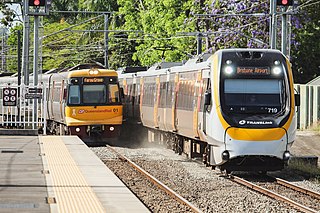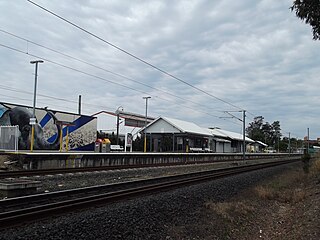
The Cleveland railway line is a suburban railway line extending 37.3 kilometres (23.2 mi) east-southeast from Brisbane, the state capital of Queensland, Australia. It is part of the Queensland Rail Citytrain network.

Park Road railway station is the junction station for the Gold Coast and Cleveland lines in Queensland, Australia. It serves the Brisbane suburb of Dutton Park.

Buranda railway station is located on the Cleveland line in Queensland, Australia. It is one of two stations serving the Brisbane suburb of Woolloongabba, the other being Park Road.

Rail transport in Australia is a component of the Australian transport system. It is to a large extent state-based, as each state largely has its own operations, with the interstate network being developed ever since Australia's federation in 1901. As of 2022, the Australian rail network consists of a total of 32,929 kilometres (20,461 mi) of track built to three major track gauges: 18,007 kilometres (11,189 mi) of standard gauge, 2,685 kilometres (1,668 mi) of broad gauge, and 11,914 kilometres (7,403 mi) of narrow gauge lines. Additionally, about 1,400 kilometres (870 mi) of 610 mm / 2 ft gauge lines support the sugar-cane industry. 3,488 kilometres (2,167 mi), around 11 percent of the Australian heavy railways network route-kilometres are electrified.
Australians generally assumed in the 1850s that railways would be built by the private sector. Private companies built railways in the then colonies of Victoria, opened in 1854, and New South Wales, where the company was taken over by the government before completion in 1855, due to bankruptcy. South Australia's railways were government owned from the beginning, including a horse-drawn line opened in 1854 and a steam-powered line opened in 1856. In Victoria, the private railways were soon found not to be financially viable, and existing rail networks and their expansion were taken over by the colony. Government ownership also enabled railways to be built to promote development, even if not apparently viable in strictly financial terms. The railway systems spread from the colonial capitals, except for a few lines that hauled commodities to a rural port.

The Beenleigh railway line is a suburban railway line extending 40.1 km from Park Road railway station to Beenleigh railway station. It is part of the Queensland Rail Citytrain network.

Coorparoo railway station is located on the Cleveland line in Queensland, Australia. It serves the Brisbane suburb of Coorparoo.

Norman Park railway station is located on the Cleveland line in Queensland, Australia. It serves the Brisbane suburb of Norman Park.

Morningside railway station is located on the Cleveland line in Queensland, Australia. It serves the Brisbane suburb of Morningside.

Cannon Hill railway station is located on the Cleveland line in Queensland, Australia. The station serves the Brisbane suburb of Cannon Hill. It is listed on the Brisbane Heritage Register on 30 November 2012.

Murarrie railway station is located on the Cleveland line in Queensland, Australia. It serves the Brisbane suburb of Murarrie. It opened in 1888 as Mooraree and the name of both the station and the locality were changed to Murarrie in 1907. On 15 July 1996, the Fisherman Islands line to the Port of Brisbane opened to the north of the station. To the east of the station a disused spur to Gibson Island branches off.

Hemmant railway station is located on the Cleveland line in Queensland, Australia. It serves the Brisbane suburb of Hemmant. The station opened in 1914.

Lindum railway station is located in the Bayside suburb of Lindum, on the Cleveland line in Queensland, Australia. It primarily services the Brisbane suburb of Wynnum West and the predominantly industrial areas of Hemmant. Iona College, a secondary school, is situated at its Lindum address adjacent to the railway station.

Dutton Park railway station is located on the Beenleigh line in Queensland, Australia. It serves the Brisbane suburb of Dutton Park. The station is one of the oldest on the network.

Fairfield railway station is located on the Beenleigh line in Queensland, Australia. It serves the Brisbane suburb of Fairfield.

Yeerongpilly railway station is located on the Beenleigh line in Queensland, Australia. It serves the Brisbane suburb of Yeerongpilly. Immediately south-west of the station, the Corinda line branches off.

Rocklea railway station is located on the Beenleigh line in Queensland, Australia. It serves the Brisbane suburb of Rocklea. The station opened in 1885 at the same time as the line.

The Australian Rail Track Corporation (ARTC) is an Australian Government-owned statutory corporation.

South East Queensland has a large passenger and freight railway network centred on Brisbane, the capital city of the Australian state of Queensland. Suburban and interurban passenger services in the region are operated by Queensland Rail, which also operates long-distance trains across the state. Aurizon and Pacific National operate freight services.
One Nation was an Australian Government program of infrastructure development carried out under the Keating Government from 1991 to 1996. Much of the program was implemented as a means of stimulating the economy in the aftermath of the early 1990s recession.

















